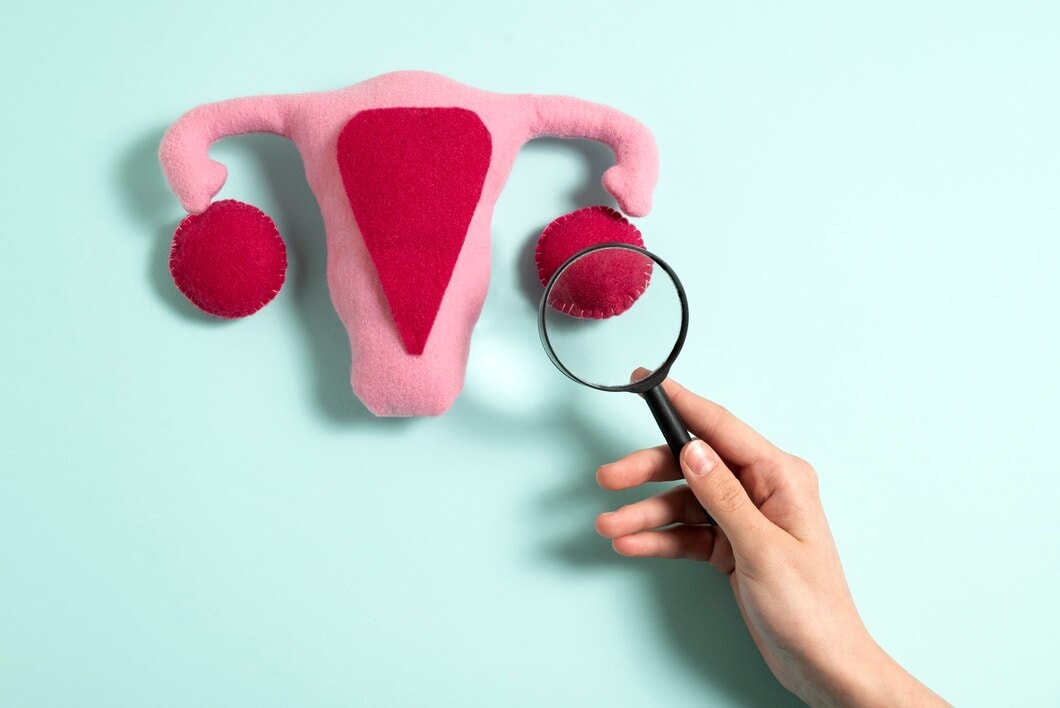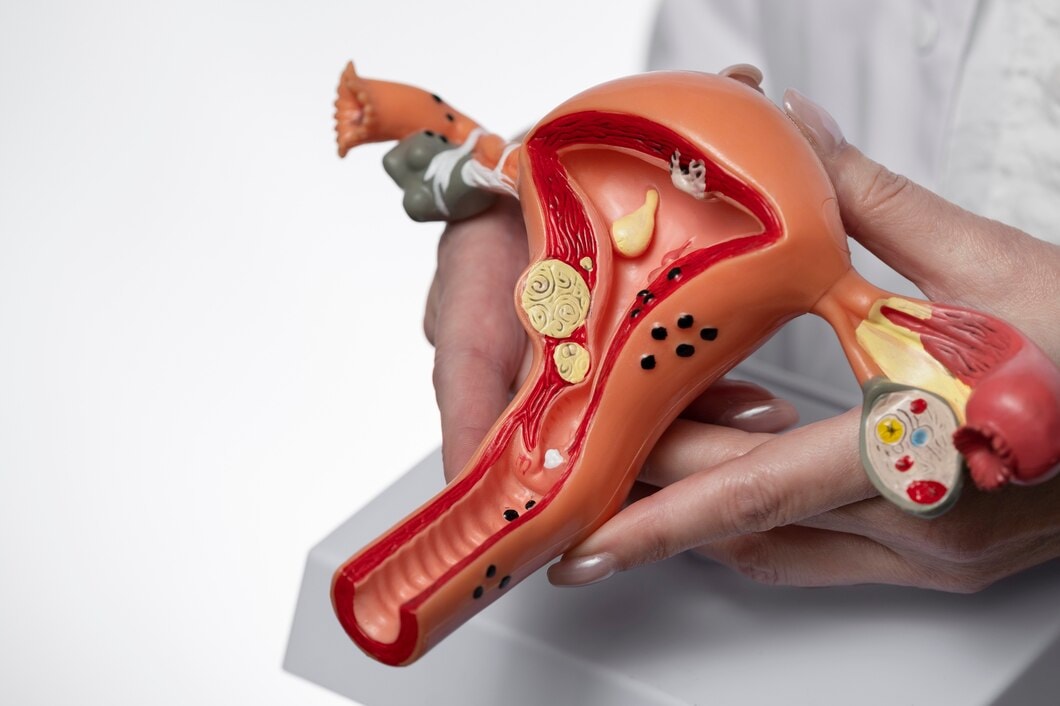Ovarian Cysts
Time to read 7 min
Time to read 7 min
WHAT IS IT?
Ovarian cysts are fluid-filled sacs or pockets within or on the surface of an ovary. Many women have ovarian cysts at some time during their lives. Most present little or no discomfort, are harmless and disappear without treatment within a few months.
Ovarian cysts typically develop as a result of the normal function of your menstrual cycle. Your ovaries normally grow cyst-like structures called follicles each month. Follicles produce the hormones estrogen and progesterone and release an egg when you ovulate. Sometimes a normal monthly follicle keeps growing. When that happens, it is known as a functional cyst.
Cysts not related to the normal function of your menstrual cycle — nonfunctional cysts — may contain tissue, such as hair, skin or teeth, because they form from cells that produce human eggs.
Or they may be filled with a watery liquid or a mucous material. These are rare.
SYMPTOM CHECKER
Some ovarian cysts — especially those that have ruptured — can produce symptoms. A large ovarian cyst can cause abdominal discomfort. If a large cyst presses on your bladder, you may feel the need to urinate more frequently because bladder capacity is reduced.
Signs and symptoms of ovarian cysts may include:
Pelvic or abdominal pain — a dull ache that may radiate to your lower back and thighs
Pelvic pain shortly before your period begins or just before it ends
Pelvic pain during intercourse
Pain during bowel movements or pressure on your bowels
Nausea, vomiting or breast tenderness similar to that experienced during pregnancy
Fullness or heaviness in your abdomen
Pressure on your bladder that causes you to urinate more frequently than normal or to have difficulty emptying your bladder completely
TREATMENT
Your doctor may recommend tests, including an ultrasound exam, to help determine the size and type of cysts. In addition to these factors, treatment will depend on your age and your signs and symptoms. Your doctor may suggest:
Watchful waiting. In many cases, you can wait to see if the cyst goes away on its own within a few months. This is typically an option if you have no symptoms and the cyst is small and filled with fluid. Your doctor will likely recommend follow-up exams to see if the cyst has changed in size.
Birth control pills. Birth control pills can reduce the chance of new cysts developing in future menstrual cycles.
Surgery. If the cyst is large, it doesn’t look like a functional cyst, it’s growing, or it persists through two or three menstrual cycles, your doctor may recommend surgery. Some cysts can be removed without removing the ovary. In some circumstances, your doctor may suggest removing the affected ovary and leaving the other ovary intact. Your doctor may also recommend surgery if a cystic mass develops on the ovaries after menopause.
Ovarian cysts are one of the most common sources of concern for many women, usually detected through annual check-ups or symptoms.
On the Mayo Clinic A to Z Health Guide, an ovarian cyst is described as a sac filled with liquid developing on or within the ovaries.
While most ovarian cysts are benign and resolve on their own, it is crucial to study the many types, symptoms, and possible complications of managing a patient with an ovarian cyst.
Below, we shall look through aspects of ovarian cysts, from causes to symptoms to types and treatment.
An ovarian cyst is a sac filled with fluid that can form on or within an ovary.
There are several cysts that are common, especially to women of childbearing years. Most ovarian cysts are generally a regular occurrence in the menstrual cycle and are called functional cysts.
These cysts are developed as a result of the natural ovary's egg-producing process and releasing the eggs. Many ovarian cysts are asymptomatic, and most are discovered during a pelvic exam.
There are several types of ovarian cysts and, hence, varying characteristics and implications. The Mayo Clinic reports some of the most common types:

These are the most common type of ovarian cyst and are directly linked to the menstrual cycle. They include:
- Follicular Cyst: In your menstrual cycle, an egg develops inside a small sac called a follicle.
Usually, the follicle opens to discharge the egg, but if it is not ruptured, fluid can accumulate in that follicle to make it a cyst.
- Corpus Luteum Cyst: Sometimes, after releasing an egg, the empty sac just sits there. If it stays that way, fluid fills the sac to make a corpus luteum cyst.
A condition characterized by small cysts over the ovaries, which leads to hormonal imbalances, resulting in irregular menstrual cycles.
These comprise fewer numbers and can be quite large in size. Dermoid cysts contain hair, skin, or even teeth, while cystadenomas consist of sanguineous or a fluid-filled state with a highly viscous mucous.
These are actually cysts that develop because of endometriosis, in which tissues that resemble the lining of the uterus start growing outside of it.
Large cysts might sometimes cause the ovary to move from its ordinary position, thus increasing its risk of painful twisting which is known as ovarian torsion.
This cuts off blood supply to the ovary resulting in severe pain and need for emergency treatment.

The symptoms of an ovarian cyst can be very variable, depending on the size and nature of the cyst and if it has ruptured or created some other complications.
Most ovarian cysts are asymptomatic, but you may have these symptoms if you have an ovarian cyst: Pelvic pain on one side
- Ache or feeling of fullness or heaviness within your abdomen
- Swelling or bloating
- Pelvic pain during intercourse or bowel movements
- You have heavier or lighter periods
At other times, ovarian cysts may cause severe pain, most of which is due to rupture or complications such as ovarian torsion.
Should you suddenly experience severe pelvic pain, fever, or vomiting, you need to be rushed to the hospital as an emergency.

Ovarian cysts are often discovered during a pelvic exam. Your physician will likely have you see other specialists for further testing that may include:
- Ultrasound: This imaging test employs sound waves to produce an image of your ovaries, which will assist in determining its size, location, and whether or not it is filled with liquid, solid, or mixed.
- Blood Tests: If you have a cyst, your doctor may test your blood for levels of CA-125, a protein marker that is often elevated in ovarian cancer, especially if you have risk factors for ovarian cancer.
Most ovarian cysts are benign and resolve spontaneously in a few months, especially functional ovarian cysts. These cysts usually resolve spontaneously as part of the normal menstrual cycle.
However, if the cyst is large, persistent, or symptomatic, your doctor may advise you to seek treatment.
Although most ovarian cysts are benign, here are situations where they can cause complications:
- Ovarian torsion: This is a serious condition in which a large cyst will cause ovary twisting and cutting off its blood supply. It is characterized by severe, sharp abdominal pain with nausea and vomiting.
The condition can be treated using surgery if the torsion is corrected for the affected ovaries to recover.
- Ruptured cysts: A cyst sometimes ruptures leading to searing pain, internal bleeding, and may require surgery.
- Risk of Ovarian Cancer: A very few ovarian cysts are risk factors in terms of ovarian cancer, which arises if the cyst is there after menopause.
If it doesn't disappear on its own and is painful, here are the treatments that are available to you:
1. Monitoring: Doctors usually recommend monitoring the cyst for some months in order to see whether it will resolve spontaneously.
2. Treatment: Birth control pills prevent the formation of new cysts and help regulate your menstrual cycle.
3. Surgery: A large, persistent, or suspicious cyst requires surgical removal of the cyst or the entire ovary. This is done more often if there is a possibility for ovarian cancer.
While it is not possible to prevent one from forming cysts, some lifestyle modifications and check-ups may help keep things in check:
Maintain a healthy weight and diet
Hormonal birth control may help to regulate your menstrual cycle
Pelvic exams may also keep cysts under cover before they lead to symptoms
Ovarian cysts are a very common gynecologic condition that most women experience in the course of their life. Most ovarian cysts are benign and resolve spontaneously without treatment.
The knowledge of symptoms, types, and complications of ovarian cysts is crucial.
If you experience persistent pelvic pain, heavy bleeding or some other symptoms, be seen by your healthcare provider immediately to be evaluated.
For this reason, early detection and treatment prevent complications and help to protect the ovaries.
Most ovarian cysts do not interfere with a person's fertility. However, certain disorders, such as polycystic ovary syndrome (PCOS), can affect fertility through hormonal imbalance.
No, surgery is only considered in cases of large, persistent, or cancerous cysts. In fact, most cysts disappear without any medical intervention.
The risk of developing cysts could be minimized through proper pelvic exams, healthy lifestyles, and the use of hormonal birth control methods.
Ovarian cysts are one of the common problems of health that can affect your well-being.
With information and discussion in consultation with your healthcare provider, you can successfully manage and treat ovarian cysts.
* Medical Disclaimer - The following information is for educational purposes only. No information provided on this website, including text, graphic, and images, are intended as substitutes for professional medical advice. Please consult with your doctor about specific medical advice pertaining to your condition(s).